Pathogenicity of Escherichia coli: Mechanisms and Disease Association
VerifiedAdded on 2022/08/17
|11
|2692
|14
Report
AI Summary
This report provides a comprehensive review of the pathogenicity of Escherichia coli (E. coli), a bacterium that resides in the gut of humans and animals but can evolve into a pathogen under various selective pressures. The paper explores the mechanisms by which E. coli acquires virulence factors, leading to the development of different pathotypes, including EPEC, EAEC, EHEC, ETEC, EIEC, and UPEC, and the diseases they cause, such as diarrhea, hemorrhagic colitis, and urinary tract infections. The report discusses the evolution of pathogenic E. coli through horizontal gene transfer, bacteriophages, and gene loss, highlighting the pathogenic mechanisms of each pathotype, including adherence, invasion, and toxin production. Furthermore, it examines the diseases associated with these pathotypes, emphasizing their transmission from animals and the environment to humans. The report concludes that the development of disease-causing virulence factors is primarily driven by alterations in the host's microenvironment. The report references several scholarly articles and research papers to support its findings.
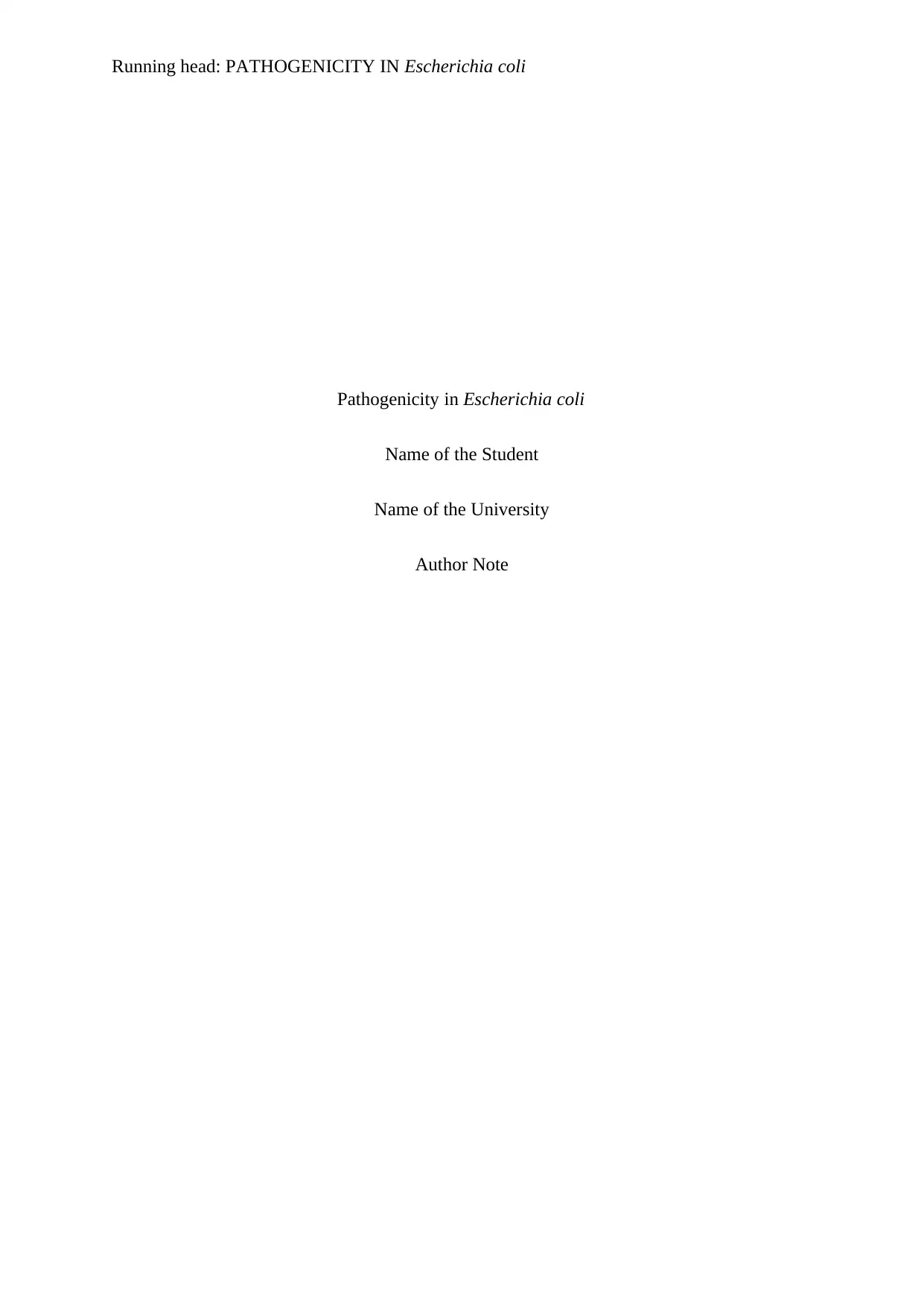
Running head: PATHOGENICITY IN Escherichia coli
Pathogenicity in Escherichia coli
Name of the Student
Name of the University
Author Note
Pathogenicity in Escherichia coli
Name of the Student
Name of the University
Author Note
Paraphrase This Document
Need a fresh take? Get an instant paraphrase of this document with our AI Paraphraser
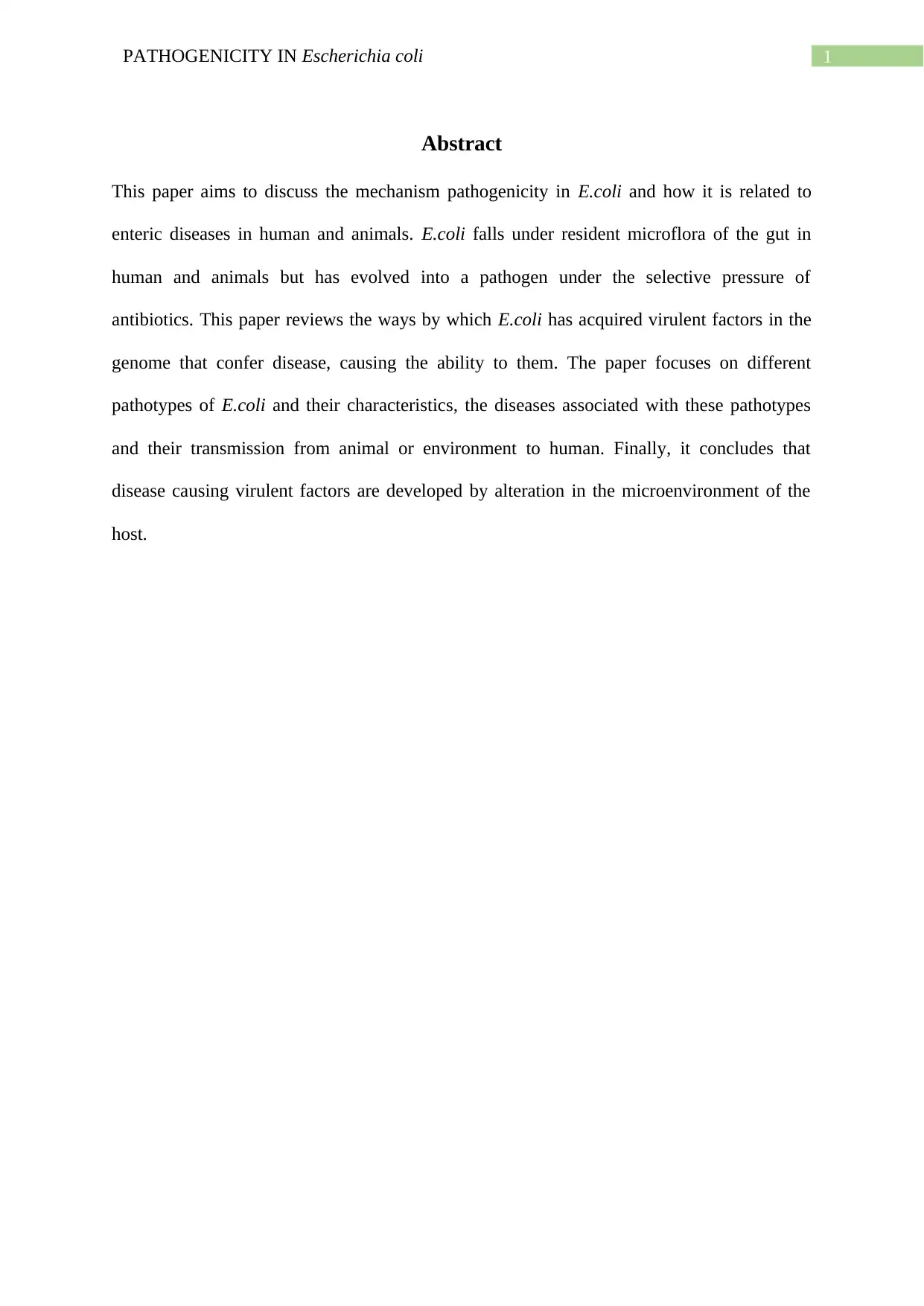
1PATHOGENICITY IN Escherichia coli
Abstract
This paper aims to discuss the mechanism pathogenicity in E.coli and how it is related to
enteric diseases in human and animals. E.coli falls under resident microflora of the gut in
human and animals but has evolved into a pathogen under the selective pressure of
antibiotics. This paper reviews the ways by which E.coli has acquired virulent factors in the
genome that confer disease, causing the ability to them. The paper focuses on different
pathotypes of E.coli and their characteristics, the diseases associated with these pathotypes
and their transmission from animal or environment to human. Finally, it concludes that
disease causing virulent factors are developed by alteration in the microenvironment of the
host.
Abstract
This paper aims to discuss the mechanism pathogenicity in E.coli and how it is related to
enteric diseases in human and animals. E.coli falls under resident microflora of the gut in
human and animals but has evolved into a pathogen under the selective pressure of
antibiotics. This paper reviews the ways by which E.coli has acquired virulent factors in the
genome that confer disease, causing the ability to them. The paper focuses on different
pathotypes of E.coli and their characteristics, the diseases associated with these pathotypes
and their transmission from animal or environment to human. Finally, it concludes that
disease causing virulent factors are developed by alteration in the microenvironment of the
host.
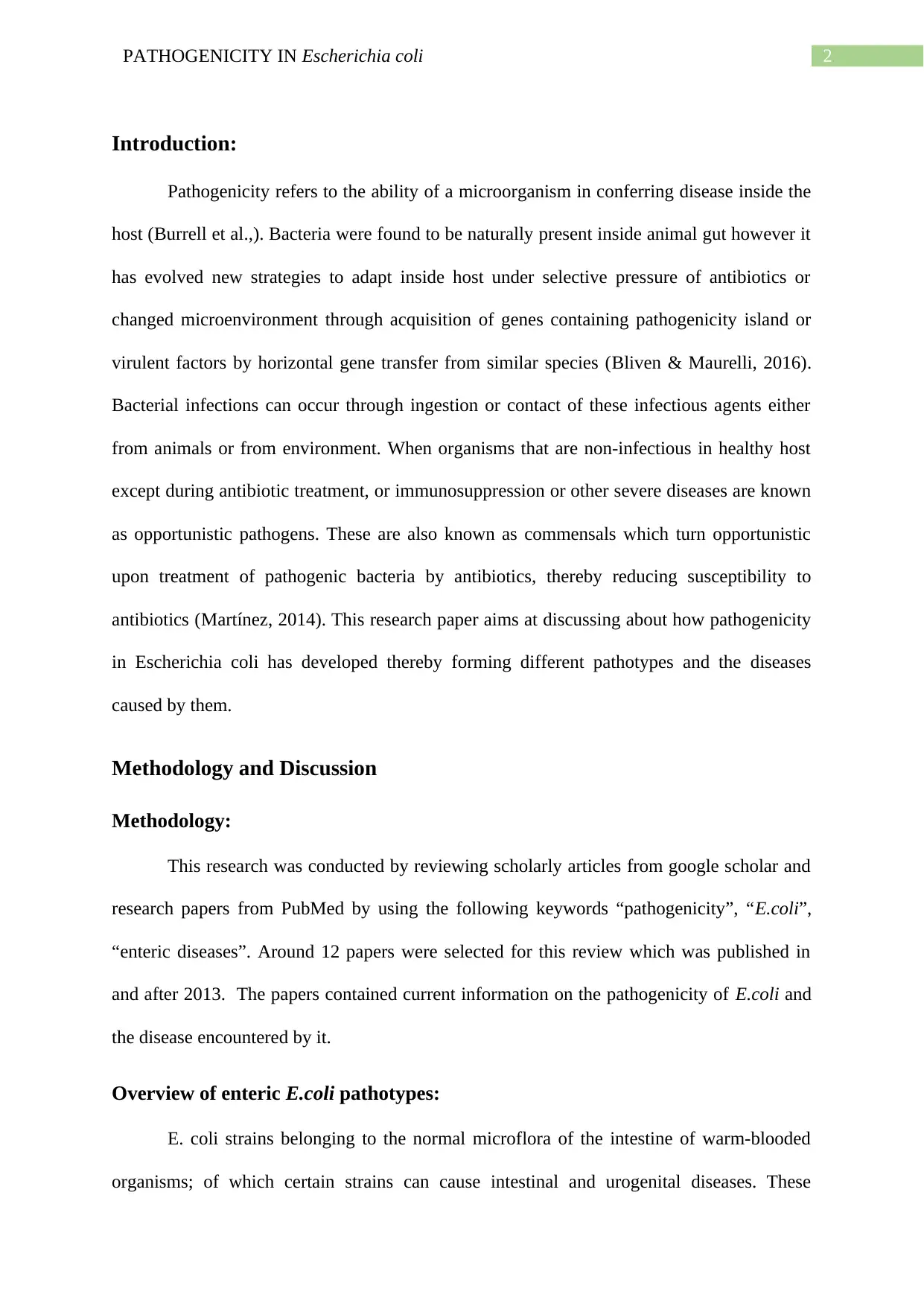
2PATHOGENICITY IN Escherichia coli
Introduction:
Pathogenicity refers to the ability of a microorganism in conferring disease inside the
host (Burrell et al.,). Bacteria were found to be naturally present inside animal gut however it
has evolved new strategies to adapt inside host under selective pressure of antibiotics or
changed microenvironment through acquisition of genes containing pathogenicity island or
virulent factors by horizontal gene transfer from similar species (Bliven & Maurelli, 2016).
Bacterial infections can occur through ingestion or contact of these infectious agents either
from animals or from environment. When organisms that are non-infectious in healthy host
except during antibiotic treatment, or immunosuppression or other severe diseases are known
as opportunistic pathogens. These are also known as commensals which turn opportunistic
upon treatment of pathogenic bacteria by antibiotics, thereby reducing susceptibility to
antibiotics (Martínez, 2014). This research paper aims at discussing about how pathogenicity
in Escherichia coli has developed thereby forming different pathotypes and the diseases
caused by them.
Methodology and Discussion
Methodology:
This research was conducted by reviewing scholarly articles from google scholar and
research papers from PubMed by using the following keywords “pathogenicity”, “E.coli”,
“enteric diseases”. Around 12 papers were selected for this review which was published in
and after 2013. The papers contained current information on the pathogenicity of E.coli and
the disease encountered by it.
Overview of enteric E.coli pathotypes:
E. coli strains belonging to the normal microflora of the intestine of warm-blooded
organisms; of which certain strains can cause intestinal and urogenital diseases. These
Introduction:
Pathogenicity refers to the ability of a microorganism in conferring disease inside the
host (Burrell et al.,). Bacteria were found to be naturally present inside animal gut however it
has evolved new strategies to adapt inside host under selective pressure of antibiotics or
changed microenvironment through acquisition of genes containing pathogenicity island or
virulent factors by horizontal gene transfer from similar species (Bliven & Maurelli, 2016).
Bacterial infections can occur through ingestion or contact of these infectious agents either
from animals or from environment. When organisms that are non-infectious in healthy host
except during antibiotic treatment, or immunosuppression or other severe diseases are known
as opportunistic pathogens. These are also known as commensals which turn opportunistic
upon treatment of pathogenic bacteria by antibiotics, thereby reducing susceptibility to
antibiotics (Martínez, 2014). This research paper aims at discussing about how pathogenicity
in Escherichia coli has developed thereby forming different pathotypes and the diseases
caused by them.
Methodology and Discussion
Methodology:
This research was conducted by reviewing scholarly articles from google scholar and
research papers from PubMed by using the following keywords “pathogenicity”, “E.coli”,
“enteric diseases”. Around 12 papers were selected for this review which was published in
and after 2013. The papers contained current information on the pathogenicity of E.coli and
the disease encountered by it.
Overview of enteric E.coli pathotypes:
E. coli strains belonging to the normal microflora of the intestine of warm-blooded
organisms; of which certain strains can cause intestinal and urogenital diseases. These
⊘ This is a preview!⊘
Do you want full access?
Subscribe today to unlock all pages.

Trusted by 1+ million students worldwide
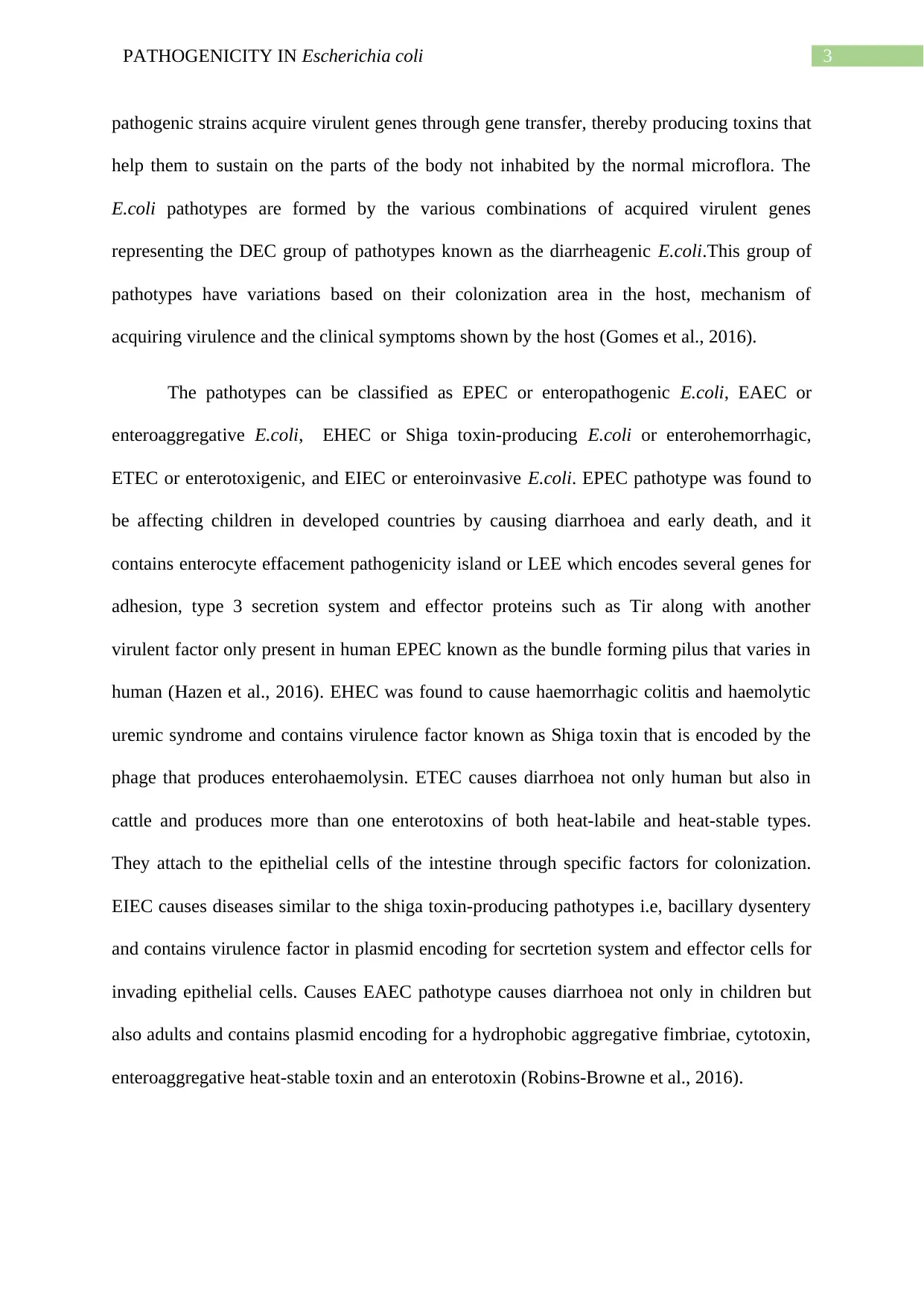
3PATHOGENICITY IN Escherichia coli
pathogenic strains acquire virulent genes through gene transfer, thereby producing toxins that
help them to sustain on the parts of the body not inhabited by the normal microflora. The
E.coli pathotypes are formed by the various combinations of acquired virulent genes
representing the DEC group of pathotypes known as the diarrheagenic E.coli.This group of
pathotypes have variations based on their colonization area in the host, mechanism of
acquiring virulence and the clinical symptoms shown by the host (Gomes et al., 2016).
The pathotypes can be classified as EPEC or enteropathogenic E.coli, EAEC or
enteroaggregative E.coli, EHEC or Shiga toxin-producing E.coli or enterohemorrhagic,
ETEC or enterotoxigenic, and EIEC or enteroinvasive E.coli. EPEC pathotype was found to
be affecting children in developed countries by causing diarrhoea and early death, and it
contains enterocyte effacement pathogenicity island or LEE which encodes several genes for
adhesion, type 3 secretion system and effector proteins such as Tir along with another
virulent factor only present in human EPEC known as the bundle forming pilus that varies in
human (Hazen et al., 2016). EHEC was found to cause haemorrhagic colitis and haemolytic
uremic syndrome and contains virulence factor known as Shiga toxin that is encoded by the
phage that produces enterohaemolysin. ETEC causes diarrhoea not only human but also in
cattle and produces more than one enterotoxins of both heat-labile and heat-stable types.
They attach to the epithelial cells of the intestine through specific factors for colonization.
EIEC causes diseases similar to the shiga toxin-producing pathotypes i.e, bacillary dysentery
and contains virulence factor in plasmid encoding for secrtetion system and effector cells for
invading epithelial cells. Causes EAEC pathotype causes diarrhoea not only in children but
also adults and contains plasmid encoding for a hydrophobic aggregative fimbriae, cytotoxin,
enteroaggregative heat-stable toxin and an enterotoxin (Robins-Browne et al., 2016).
pathogenic strains acquire virulent genes through gene transfer, thereby producing toxins that
help them to sustain on the parts of the body not inhabited by the normal microflora. The
E.coli pathotypes are formed by the various combinations of acquired virulent genes
representing the DEC group of pathotypes known as the diarrheagenic E.coli.This group of
pathotypes have variations based on their colonization area in the host, mechanism of
acquiring virulence and the clinical symptoms shown by the host (Gomes et al., 2016).
The pathotypes can be classified as EPEC or enteropathogenic E.coli, EAEC or
enteroaggregative E.coli, EHEC or Shiga toxin-producing E.coli or enterohemorrhagic,
ETEC or enterotoxigenic, and EIEC or enteroinvasive E.coli. EPEC pathotype was found to
be affecting children in developed countries by causing diarrhoea and early death, and it
contains enterocyte effacement pathogenicity island or LEE which encodes several genes for
adhesion, type 3 secretion system and effector proteins such as Tir along with another
virulent factor only present in human EPEC known as the bundle forming pilus that varies in
human (Hazen et al., 2016). EHEC was found to cause haemorrhagic colitis and haemolytic
uremic syndrome and contains virulence factor known as Shiga toxin that is encoded by the
phage that produces enterohaemolysin. ETEC causes diarrhoea not only human but also in
cattle and produces more than one enterotoxins of both heat-labile and heat-stable types.
They attach to the epithelial cells of the intestine through specific factors for colonization.
EIEC causes diseases similar to the shiga toxin-producing pathotypes i.e, bacillary dysentery
and contains virulence factor in plasmid encoding for secrtetion system and effector cells for
invading epithelial cells. Causes EAEC pathotype causes diarrhoea not only in children but
also adults and contains plasmid encoding for a hydrophobic aggregative fimbriae, cytotoxin,
enteroaggregative heat-stable toxin and an enterotoxin (Robins-Browne et al., 2016).
Paraphrase This Document
Need a fresh take? Get an instant paraphrase of this document with our AI Paraphraser
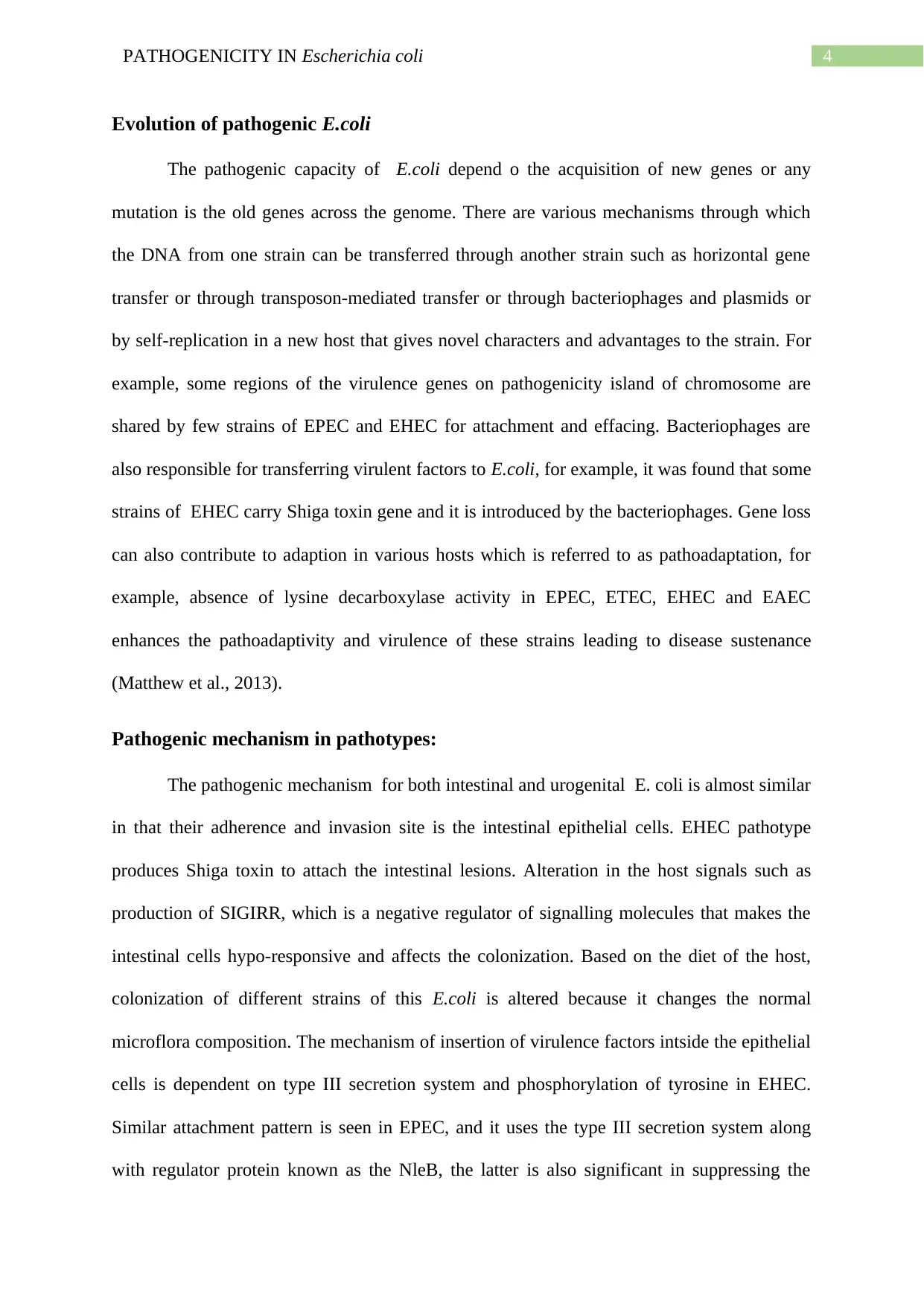
4PATHOGENICITY IN Escherichia coli
Evolution of pathogenic E.coli
The pathogenic capacity of E.coli depend o the acquisition of new genes or any
mutation is the old genes across the genome. There are various mechanisms through which
the DNA from one strain can be transferred through another strain such as horizontal gene
transfer or through transposon-mediated transfer or through bacteriophages and plasmids or
by self-replication in a new host that gives novel characters and advantages to the strain. For
example, some regions of the virulence genes on pathogenicity island of chromosome are
shared by few strains of EPEC and EHEC for attachment and effacing. Bacteriophages are
also responsible for transferring virulent factors to E.coli, for example, it was found that some
strains of EHEC carry Shiga toxin gene and it is introduced by the bacteriophages. Gene loss
can also contribute to adaption in various hosts which is referred to as pathoadaptation, for
example, absence of lysine decarboxylase activity in EPEC, ETEC, EHEC and EAEC
enhances the pathoadaptivity and virulence of these strains leading to disease sustenance
(Matthew et al., 2013).
Pathogenic mechanism in pathotypes:
The pathogenic mechanism for both intestinal and urogenital E. coli is almost similar
in that their adherence and invasion site is the intestinal epithelial cells. EHEC pathotype
produces Shiga toxin to attach the intestinal lesions. Alteration in the host signals such as
production of SIGIRR, which is a negative regulator of signalling molecules that makes the
intestinal cells hypo-responsive and affects the colonization. Based on the diet of the host,
colonization of different strains of this E.coli is altered because it changes the normal
microflora composition. The mechanism of insertion of virulence factors intside the epithelial
cells is dependent on type III secretion system and phosphorylation of tyrosine in EHEC.
Similar attachment pattern is seen in EPEC, and it uses the type III secretion system along
with regulator protein known as the NleB, the latter is also significant in suppressing the
Evolution of pathogenic E.coli
The pathogenic capacity of E.coli depend o the acquisition of new genes or any
mutation is the old genes across the genome. There are various mechanisms through which
the DNA from one strain can be transferred through another strain such as horizontal gene
transfer or through transposon-mediated transfer or through bacteriophages and plasmids or
by self-replication in a new host that gives novel characters and advantages to the strain. For
example, some regions of the virulence genes on pathogenicity island of chromosome are
shared by few strains of EPEC and EHEC for attachment and effacing. Bacteriophages are
also responsible for transferring virulent factors to E.coli, for example, it was found that some
strains of EHEC carry Shiga toxin gene and it is introduced by the bacteriophages. Gene loss
can also contribute to adaption in various hosts which is referred to as pathoadaptation, for
example, absence of lysine decarboxylase activity in EPEC, ETEC, EHEC and EAEC
enhances the pathoadaptivity and virulence of these strains leading to disease sustenance
(Matthew et al., 2013).
Pathogenic mechanism in pathotypes:
The pathogenic mechanism for both intestinal and urogenital E. coli is almost similar
in that their adherence and invasion site is the intestinal epithelial cells. EHEC pathotype
produces Shiga toxin to attach the intestinal lesions. Alteration in the host signals such as
production of SIGIRR, which is a negative regulator of signalling molecules that makes the
intestinal cells hypo-responsive and affects the colonization. Based on the diet of the host,
colonization of different strains of this E.coli is altered because it changes the normal
microflora composition. The mechanism of insertion of virulence factors intside the epithelial
cells is dependent on type III secretion system and phosphorylation of tyrosine in EHEC.
Similar attachment pattern is seen in EPEC, and it uses the type III secretion system along
with regulator protein known as the NleB, the latter is also significant in suppressing the
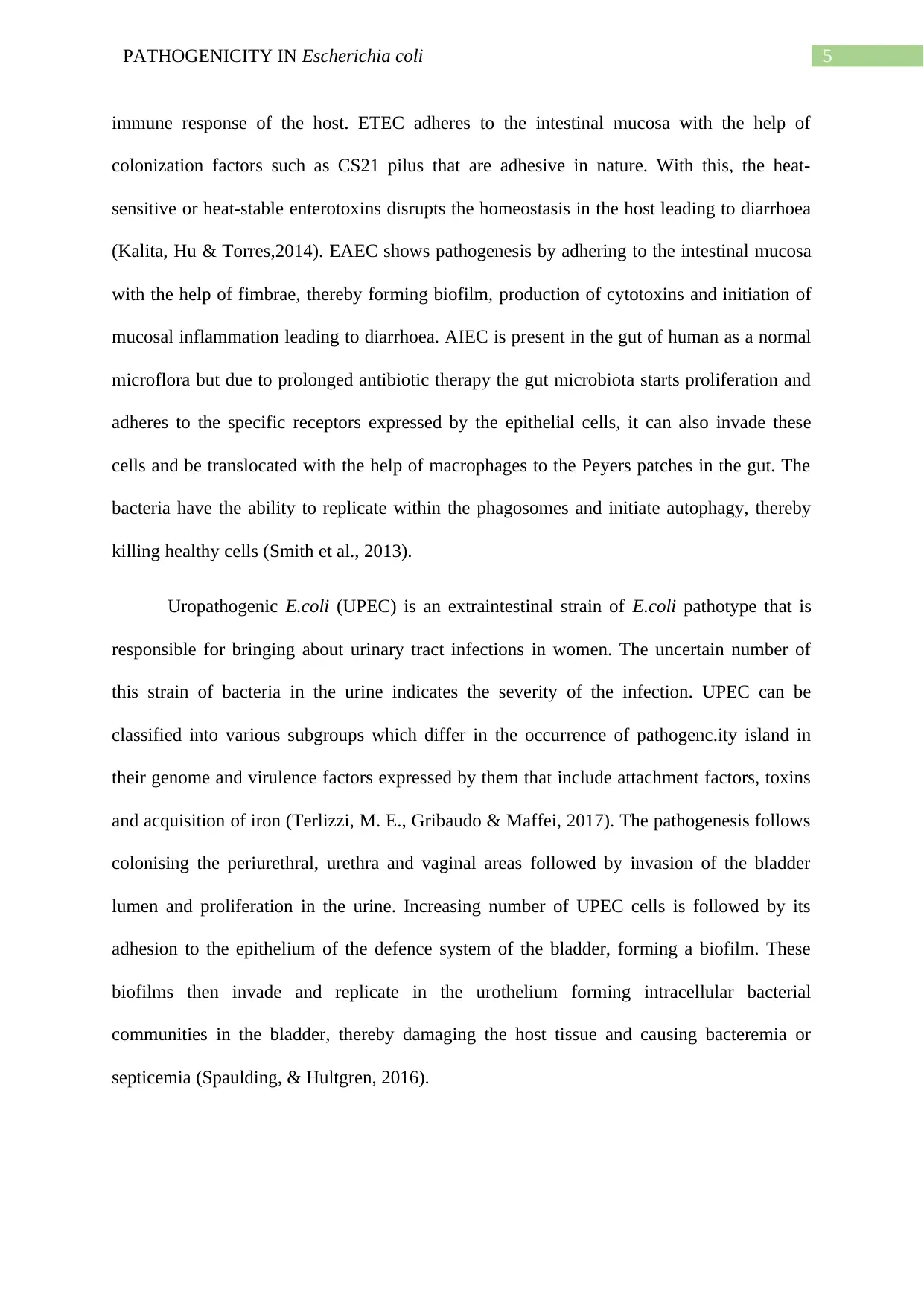
5PATHOGENICITY IN Escherichia coli
immune response of the host. ETEC adheres to the intestinal mucosa with the help of
colonization factors such as CS21 pilus that are adhesive in nature. With this, the heat-
sensitive or heat-stable enterotoxins disrupts the homeostasis in the host leading to diarrhoea
(Kalita, Hu & Torres,2014). EAEC shows pathogenesis by adhering to the intestinal mucosa
with the help of fimbrae, thereby forming biofilm, production of cytotoxins and initiation of
mucosal inflammation leading to diarrhoea. AIEC is present in the gut of human as a normal
microflora but due to prolonged antibiotic therapy the gut microbiota starts proliferation and
adheres to the specific receptors expressed by the epithelial cells, it can also invade these
cells and be translocated with the help of macrophages to the Peyers patches in the gut. The
bacteria have the ability to replicate within the phagosomes and initiate autophagy, thereby
killing healthy cells (Smith et al., 2013).
Uropathogenic E.coli (UPEC) is an extraintestinal strain of E.coli pathotype that is
responsible for bringing about urinary tract infections in women. The uncertain number of
this strain of bacteria in the urine indicates the severity of the infection. UPEC can be
classified into various subgroups which differ in the occurrence of pathogenc.ity island in
their genome and virulence factors expressed by them that include attachment factors, toxins
and acquisition of iron (Terlizzi, M. E., Gribaudo & Maffei, 2017). The pathogenesis follows
colonising the periurethral, urethra and vaginal areas followed by invasion of the bladder
lumen and proliferation in the urine. Increasing number of UPEC cells is followed by its
adhesion to the epithelium of the defence system of the bladder, forming a biofilm. These
biofilms then invade and replicate in the urothelium forming intracellular bacterial
communities in the bladder, thereby damaging the host tissue and causing bacteremia or
septicemia (Spaulding, & Hultgren, 2016).
immune response of the host. ETEC adheres to the intestinal mucosa with the help of
colonization factors such as CS21 pilus that are adhesive in nature. With this, the heat-
sensitive or heat-stable enterotoxins disrupts the homeostasis in the host leading to diarrhoea
(Kalita, Hu & Torres,2014). EAEC shows pathogenesis by adhering to the intestinal mucosa
with the help of fimbrae, thereby forming biofilm, production of cytotoxins and initiation of
mucosal inflammation leading to diarrhoea. AIEC is present in the gut of human as a normal
microflora but due to prolonged antibiotic therapy the gut microbiota starts proliferation and
adheres to the specific receptors expressed by the epithelial cells, it can also invade these
cells and be translocated with the help of macrophages to the Peyers patches in the gut. The
bacteria have the ability to replicate within the phagosomes and initiate autophagy, thereby
killing healthy cells (Smith et al., 2013).
Uropathogenic E.coli (UPEC) is an extraintestinal strain of E.coli pathotype that is
responsible for bringing about urinary tract infections in women. The uncertain number of
this strain of bacteria in the urine indicates the severity of the infection. UPEC can be
classified into various subgroups which differ in the occurrence of pathogenc.ity island in
their genome and virulence factors expressed by them that include attachment factors, toxins
and acquisition of iron (Terlizzi, M. E., Gribaudo & Maffei, 2017). The pathogenesis follows
colonising the periurethral, urethra and vaginal areas followed by invasion of the bladder
lumen and proliferation in the urine. Increasing number of UPEC cells is followed by its
adhesion to the epithelium of the defence system of the bladder, forming a biofilm. These
biofilms then invade and replicate in the urothelium forming intracellular bacterial
communities in the bladder, thereby damaging the host tissue and causing bacteremia or
septicemia (Spaulding, & Hultgren, 2016).
⊘ This is a preview!⊘
Do you want full access?
Subscribe today to unlock all pages.

Trusted by 1+ million students worldwide
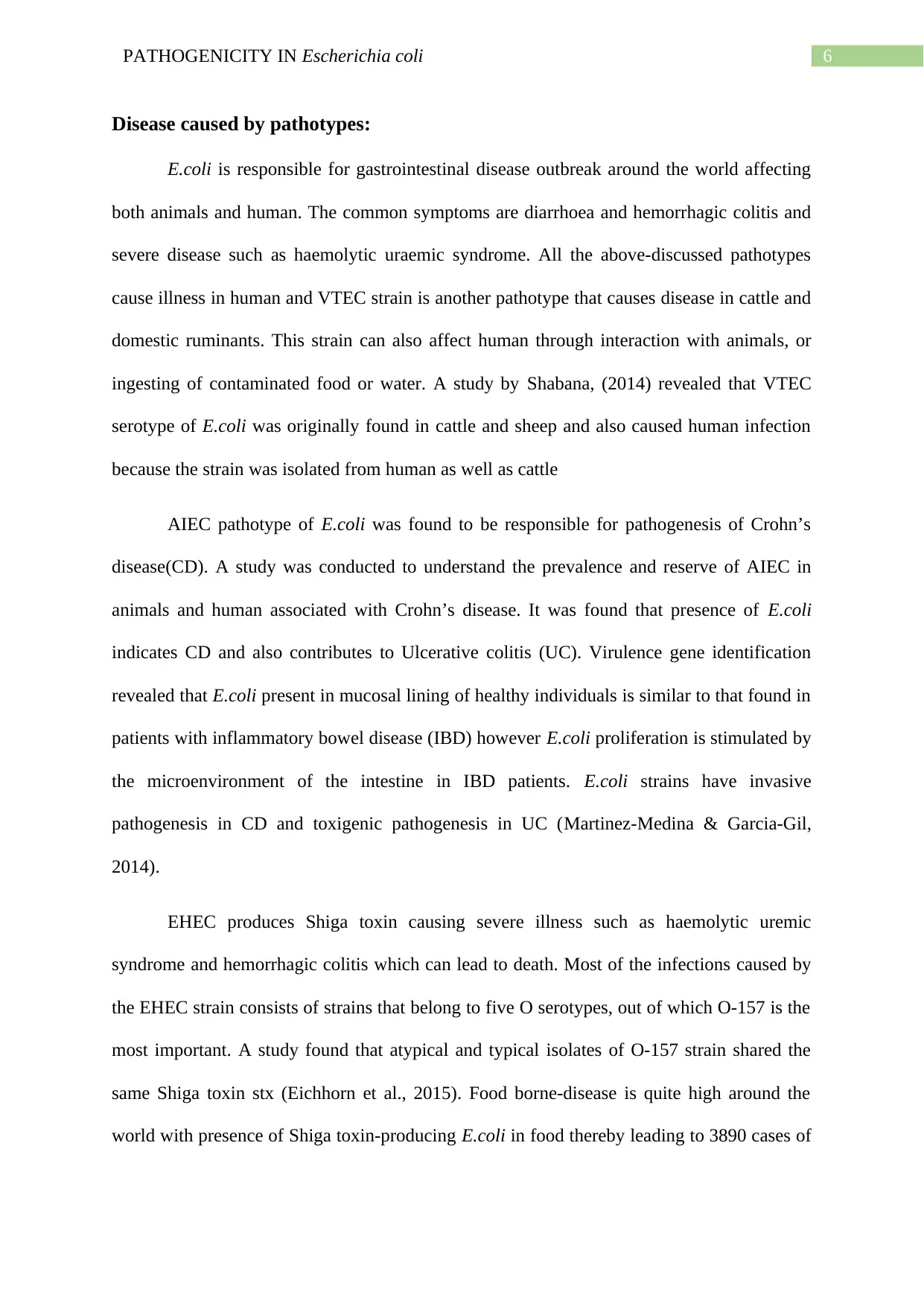
6PATHOGENICITY IN Escherichia coli
Disease caused by pathotypes:
E.coli is responsible for gastrointestinal disease outbreak around the world affecting
both animals and human. The common symptoms are diarrhoea and hemorrhagic colitis and
severe disease such as haemolytic uraemic syndrome. All the above-discussed pathotypes
cause illness in human and VTEC strain is another pathotype that causes disease in cattle and
domestic ruminants. This strain can also affect human through interaction with animals, or
ingesting of contaminated food or water. A study by Shabana, (2014) revealed that VTEC
serotype of E.coli was originally found in cattle and sheep and also caused human infection
because the strain was isolated from human as well as cattle
AIEC pathotype of E.coli was found to be responsible for pathogenesis of Crohn’s
disease(CD). A study was conducted to understand the prevalence and reserve of AIEC in
animals and human associated with Crohn’s disease. It was found that presence of E.coli
indicates CD and also contributes to Ulcerative colitis (UC). Virulence gene identification
revealed that E.coli present in mucosal lining of healthy individuals is similar to that found in
patients with inflammatory bowel disease (IBD) however E.coli proliferation is stimulated by
the microenvironment of the intestine in IBD patients. E.coli strains have invasive
pathogenesis in CD and toxigenic pathogenesis in UC (Martinez-Medina & Garcia-Gil,
2014).
EHEC produces Shiga toxin causing severe illness such as haemolytic uremic
syndrome and hemorrhagic colitis which can lead to death. Most of the infections caused by
the EHEC strain consists of strains that belong to five O serotypes, out of which O-157 is the
most important. A study found that atypical and typical isolates of O-157 strain shared the
same Shiga toxin stx (Eichhorn et al., 2015). Food borne-disease is quite high around the
world with presence of Shiga toxin-producing E.coli in food thereby leading to 3890 cases of
Disease caused by pathotypes:
E.coli is responsible for gastrointestinal disease outbreak around the world affecting
both animals and human. The common symptoms are diarrhoea and hemorrhagic colitis and
severe disease such as haemolytic uraemic syndrome. All the above-discussed pathotypes
cause illness in human and VTEC strain is another pathotype that causes disease in cattle and
domestic ruminants. This strain can also affect human through interaction with animals, or
ingesting of contaminated food or water. A study by Shabana, (2014) revealed that VTEC
serotype of E.coli was originally found in cattle and sheep and also caused human infection
because the strain was isolated from human as well as cattle
AIEC pathotype of E.coli was found to be responsible for pathogenesis of Crohn’s
disease(CD). A study was conducted to understand the prevalence and reserve of AIEC in
animals and human associated with Crohn’s disease. It was found that presence of E.coli
indicates CD and also contributes to Ulcerative colitis (UC). Virulence gene identification
revealed that E.coli present in mucosal lining of healthy individuals is similar to that found in
patients with inflammatory bowel disease (IBD) however E.coli proliferation is stimulated by
the microenvironment of the intestine in IBD patients. E.coli strains have invasive
pathogenesis in CD and toxigenic pathogenesis in UC (Martinez-Medina & Garcia-Gil,
2014).
EHEC produces Shiga toxin causing severe illness such as haemolytic uremic
syndrome and hemorrhagic colitis which can lead to death. Most of the infections caused by
the EHEC strain consists of strains that belong to five O serotypes, out of which O-157 is the
most important. A study found that atypical and typical isolates of O-157 strain shared the
same Shiga toxin stx (Eichhorn et al., 2015). Food borne-disease is quite high around the
world with presence of Shiga toxin-producing E.coli in food thereby leading to 3890 cases of
Paraphrase This Document
Need a fresh take? Get an instant paraphrase of this document with our AI Paraphraser
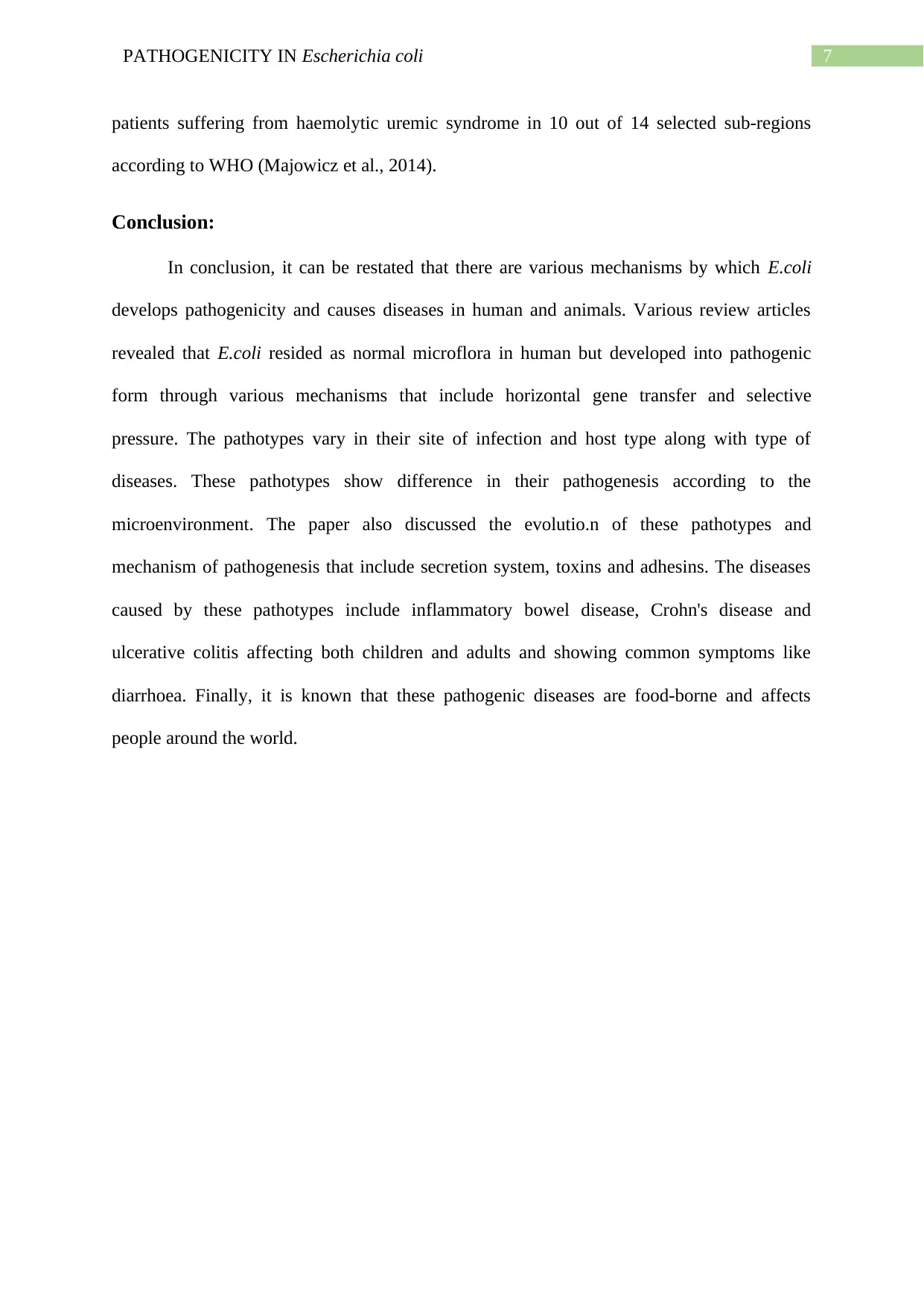
7PATHOGENICITY IN Escherichia coli
patients suffering from haemolytic uremic syndrome in 10 out of 14 selected sub-regions
according to WHO (Majowicz et al., 2014).
Conclusion:
In conclusion, it can be restated that there are various mechanisms by which E.coli
develops pathogenicity and causes diseases in human and animals. Various review articles
revealed that E.coli resided as normal microflora in human but developed into pathogenic
form through various mechanisms that include horizontal gene transfer and selective
pressure. The pathotypes vary in their site of infection and host type along with type of
diseases. These pathotypes show difference in their pathogenesis according to the
microenvironment. The paper also discussed the evolutio.n of these pathotypes and
mechanism of pathogenesis that include secretion system, toxins and adhesins. The diseases
caused by these pathotypes include inflammatory bowel disease, Crohn's disease and
ulcerative colitis affecting both children and adults and showing common symptoms like
diarrhoea. Finally, it is known that these pathogenic diseases are food-borne and affects
people around the world.
patients suffering from haemolytic uremic syndrome in 10 out of 14 selected sub-regions
according to WHO (Majowicz et al., 2014).
Conclusion:
In conclusion, it can be restated that there are various mechanisms by which E.coli
develops pathogenicity and causes diseases in human and animals. Various review articles
revealed that E.coli resided as normal microflora in human but developed into pathogenic
form through various mechanisms that include horizontal gene transfer and selective
pressure. The pathotypes vary in their site of infection and host type along with type of
diseases. These pathotypes show difference in their pathogenesis according to the
microenvironment. The paper also discussed the evolutio.n of these pathotypes and
mechanism of pathogenesis that include secretion system, toxins and adhesins. The diseases
caused by these pathotypes include inflammatory bowel disease, Crohn's disease and
ulcerative colitis affecting both children and adults and showing common symptoms like
diarrhoea. Finally, it is known that these pathogenic diseases are food-borne and affects
people around the world.
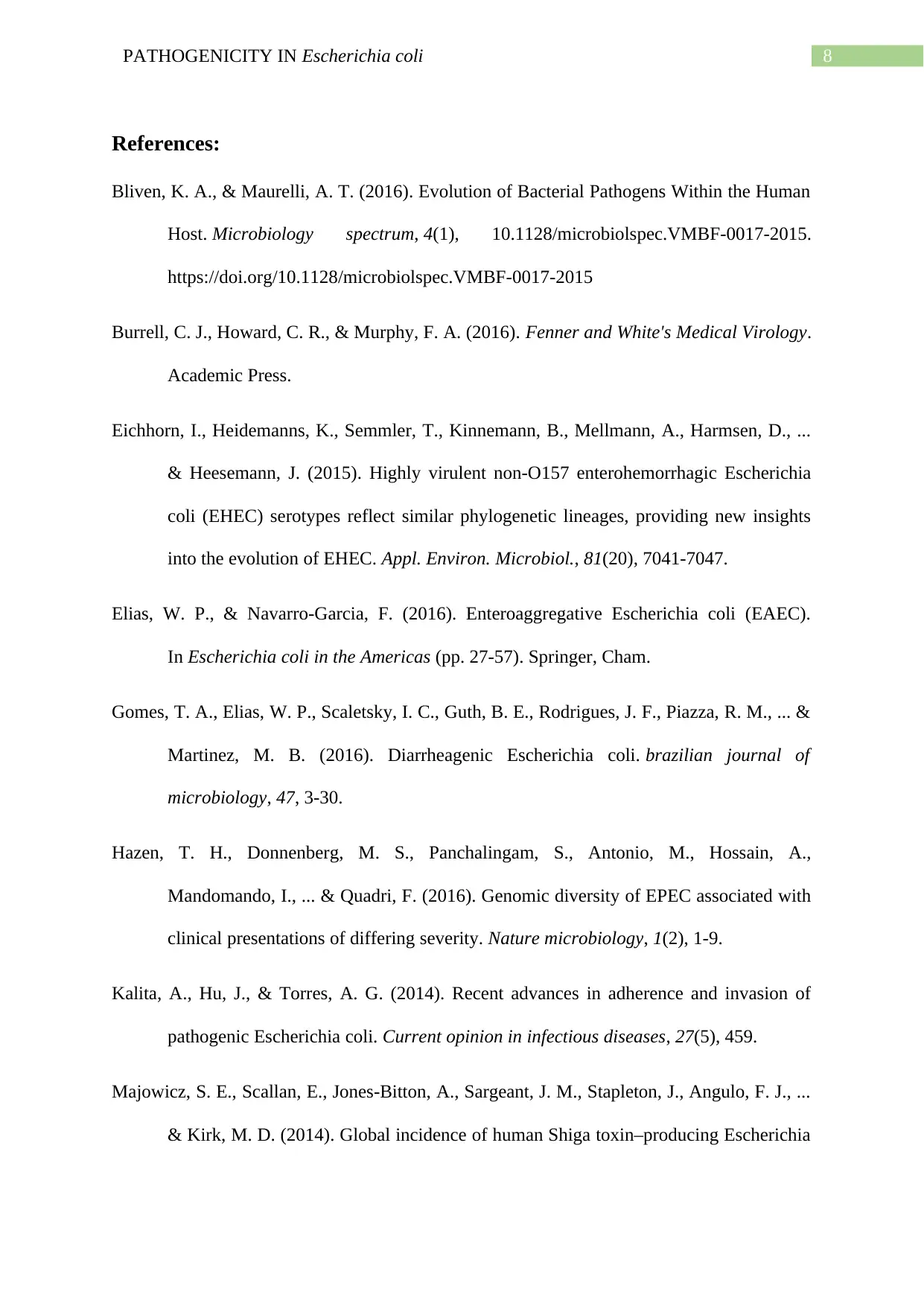
8PATHOGENICITY IN Escherichia coli
References:
Bliven, K. A., & Maurelli, A. T. (2016). Evolution of Bacterial Pathogens Within the Human
Host. Microbiology spectrum, 4(1), 10.1128/microbiolspec.VMBF-0017-2015.
https://doi.org/10.1128/microbiolspec.VMBF-0017-2015
Burrell, C. J., Howard, C. R., & Murphy, F. A. (2016). Fenner and White's Medical Virology.
Academic Press.
Eichhorn, I., Heidemanns, K., Semmler, T., Kinnemann, B., Mellmann, A., Harmsen, D., ...
& Heesemann, J. (2015). Highly virulent non-O157 enterohemorrhagic Escherichia
coli (EHEC) serotypes reflect similar phylogenetic lineages, providing new insights
into the evolution of EHEC. Appl. Environ. Microbiol., 81(20), 7041-7047.
Elias, W. P., & Navarro-Garcia, F. (2016). Enteroaggregative Escherichia coli (EAEC).
In Escherichia coli in the Americas (pp. 27-57). Springer, Cham.
Gomes, T. A., Elias, W. P., Scaletsky, I. C., Guth, B. E., Rodrigues, J. F., Piazza, R. M., ... &
Martinez, M. B. (2016). Diarrheagenic Escherichia coli. brazilian journal of
microbiology, 47, 3-30.
Hazen, T. H., Donnenberg, M. S., Panchalingam, S., Antonio, M., Hossain, A.,
Mandomando, I., ... & Quadri, F. (2016). Genomic diversity of EPEC associated with
clinical presentations of differing severity. Nature microbiology, 1(2), 1-9.
Kalita, A., Hu, J., & Torres, A. G. (2014). Recent advances in adherence and invasion of
pathogenic Escherichia coli. Current opinion in infectious diseases, 27(5), 459.
Majowicz, S. E., Scallan, E., Jones-Bitton, A., Sargeant, J. M., Stapleton, J., Angulo, F. J., ...
& Kirk, M. D. (2014). Global incidence of human Shiga toxin–producing Escherichia
References:
Bliven, K. A., & Maurelli, A. T. (2016). Evolution of Bacterial Pathogens Within the Human
Host. Microbiology spectrum, 4(1), 10.1128/microbiolspec.VMBF-0017-2015.
https://doi.org/10.1128/microbiolspec.VMBF-0017-2015
Burrell, C. J., Howard, C. R., & Murphy, F. A. (2016). Fenner and White's Medical Virology.
Academic Press.
Eichhorn, I., Heidemanns, K., Semmler, T., Kinnemann, B., Mellmann, A., Harmsen, D., ...
& Heesemann, J. (2015). Highly virulent non-O157 enterohemorrhagic Escherichia
coli (EHEC) serotypes reflect similar phylogenetic lineages, providing new insights
into the evolution of EHEC. Appl. Environ. Microbiol., 81(20), 7041-7047.
Elias, W. P., & Navarro-Garcia, F. (2016). Enteroaggregative Escherichia coli (EAEC).
In Escherichia coli in the Americas (pp. 27-57). Springer, Cham.
Gomes, T. A., Elias, W. P., Scaletsky, I. C., Guth, B. E., Rodrigues, J. F., Piazza, R. M., ... &
Martinez, M. B. (2016). Diarrheagenic Escherichia coli. brazilian journal of
microbiology, 47, 3-30.
Hazen, T. H., Donnenberg, M. S., Panchalingam, S., Antonio, M., Hossain, A.,
Mandomando, I., ... & Quadri, F. (2016). Genomic diversity of EPEC associated with
clinical presentations of differing severity. Nature microbiology, 1(2), 1-9.
Kalita, A., Hu, J., & Torres, A. G. (2014). Recent advances in adherence and invasion of
pathogenic Escherichia coli. Current opinion in infectious diseases, 27(5), 459.
Majowicz, S. E., Scallan, E., Jones-Bitton, A., Sargeant, J. M., Stapleton, J., Angulo, F. J., ...
& Kirk, M. D. (2014). Global incidence of human Shiga toxin–producing Escherichia
⊘ This is a preview!⊘
Do you want full access?
Subscribe today to unlock all pages.

Trusted by 1+ million students worldwide
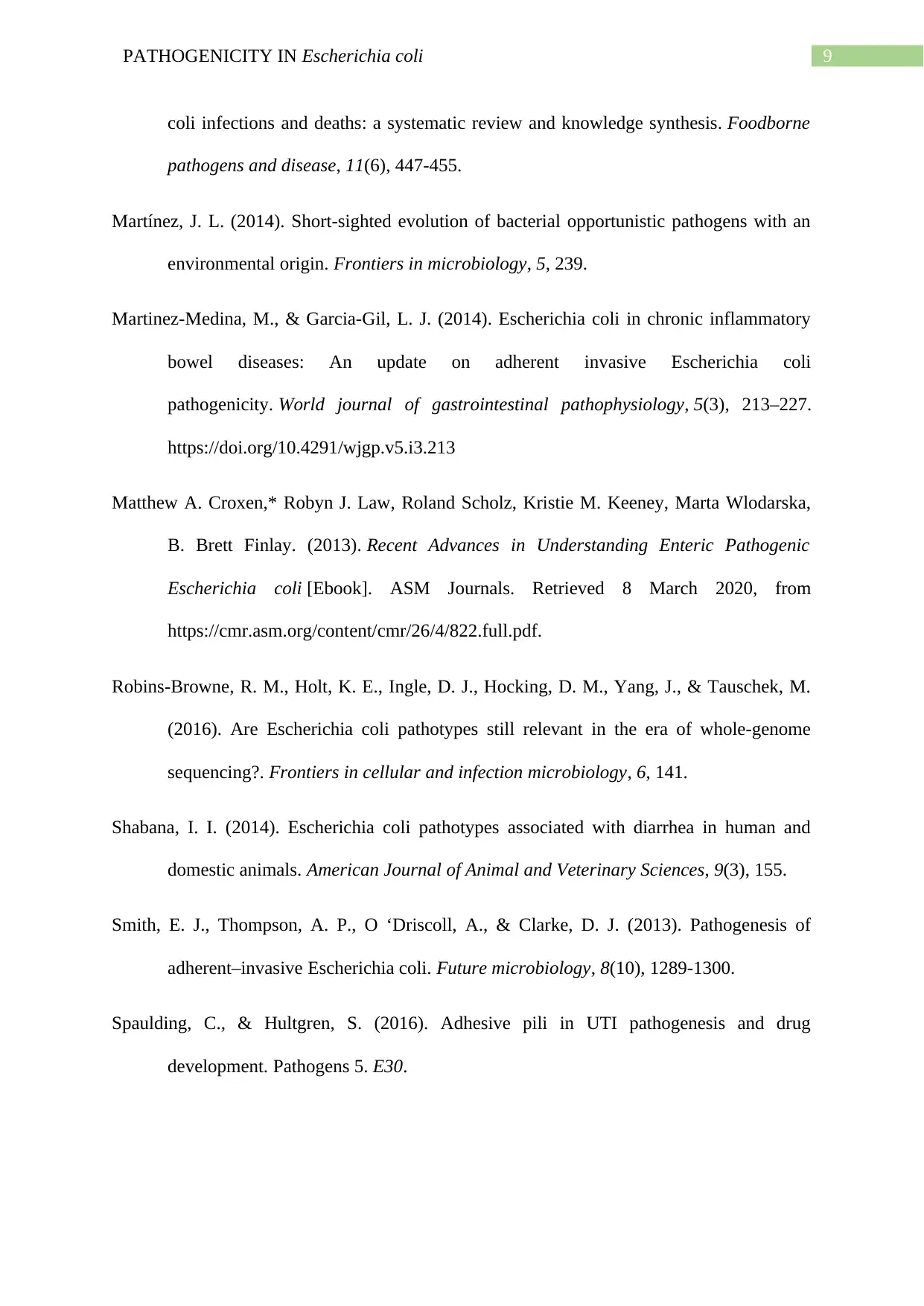
9PATHOGENICITY IN Escherichia coli
coli infections and deaths: a systematic review and knowledge synthesis. Foodborne
pathogens and disease, 11(6), 447-455.
Martínez, J. L. (2014). Short-sighted evolution of bacterial opportunistic pathogens with an
environmental origin. Frontiers in microbiology, 5, 239.
Martinez-Medina, M., & Garcia-Gil, L. J. (2014). Escherichia coli in chronic inflammatory
bowel diseases: An update on adherent invasive Escherichia coli
pathogenicity. World journal of gastrointestinal pathophysiology, 5(3), 213–227.
https://doi.org/10.4291/wjgp.v5.i3.213
Matthew A. Croxen,* Robyn J. Law, Roland Scholz, Kristie M. Keeney, Marta Wlodarska,
B. Brett Finlay. (2013). Recent Advances in Understanding Enteric Pathogenic
Escherichia coli [Ebook]. ASM Journals. Retrieved 8 March 2020, from
https://cmr.asm.org/content/cmr/26/4/822.full.pdf.
Robins-Browne, R. M., Holt, K. E., Ingle, D. J., Hocking, D. M., Yang, J., & Tauschek, M.
(2016). Are Escherichia coli pathotypes still relevant in the era of whole-genome
sequencing?. Frontiers in cellular and infection microbiology, 6, 141.
Shabana, I. I. (2014). Escherichia coli pathotypes associated with diarrhea in human and
domestic animals. American Journal of Animal and Veterinary Sciences, 9(3), 155.
Smith, E. J., Thompson, A. P., O ‘Driscoll, A., & Clarke, D. J. (2013). Pathogenesis of
adherent–invasive Escherichia coli. Future microbiology, 8(10), 1289-1300.
Spaulding, C., & Hultgren, S. (2016). Adhesive pili in UTI pathogenesis and drug
development. Pathogens 5. E30.
coli infections and deaths: a systematic review and knowledge synthesis. Foodborne
pathogens and disease, 11(6), 447-455.
Martínez, J. L. (2014). Short-sighted evolution of bacterial opportunistic pathogens with an
environmental origin. Frontiers in microbiology, 5, 239.
Martinez-Medina, M., & Garcia-Gil, L. J. (2014). Escherichia coli in chronic inflammatory
bowel diseases: An update on adherent invasive Escherichia coli
pathogenicity. World journal of gastrointestinal pathophysiology, 5(3), 213–227.
https://doi.org/10.4291/wjgp.v5.i3.213
Matthew A. Croxen,* Robyn J. Law, Roland Scholz, Kristie M. Keeney, Marta Wlodarska,
B. Brett Finlay. (2013). Recent Advances in Understanding Enteric Pathogenic
Escherichia coli [Ebook]. ASM Journals. Retrieved 8 March 2020, from
https://cmr.asm.org/content/cmr/26/4/822.full.pdf.
Robins-Browne, R. M., Holt, K. E., Ingle, D. J., Hocking, D. M., Yang, J., & Tauschek, M.
(2016). Are Escherichia coli pathotypes still relevant in the era of whole-genome
sequencing?. Frontiers in cellular and infection microbiology, 6, 141.
Shabana, I. I. (2014). Escherichia coli pathotypes associated with diarrhea in human and
domestic animals. American Journal of Animal and Veterinary Sciences, 9(3), 155.
Smith, E. J., Thompson, A. P., O ‘Driscoll, A., & Clarke, D. J. (2013). Pathogenesis of
adherent–invasive Escherichia coli. Future microbiology, 8(10), 1289-1300.
Spaulding, C., & Hultgren, S. (2016). Adhesive pili in UTI pathogenesis and drug
development. Pathogens 5. E30.
Paraphrase This Document
Need a fresh take? Get an instant paraphrase of this document with our AI Paraphraser
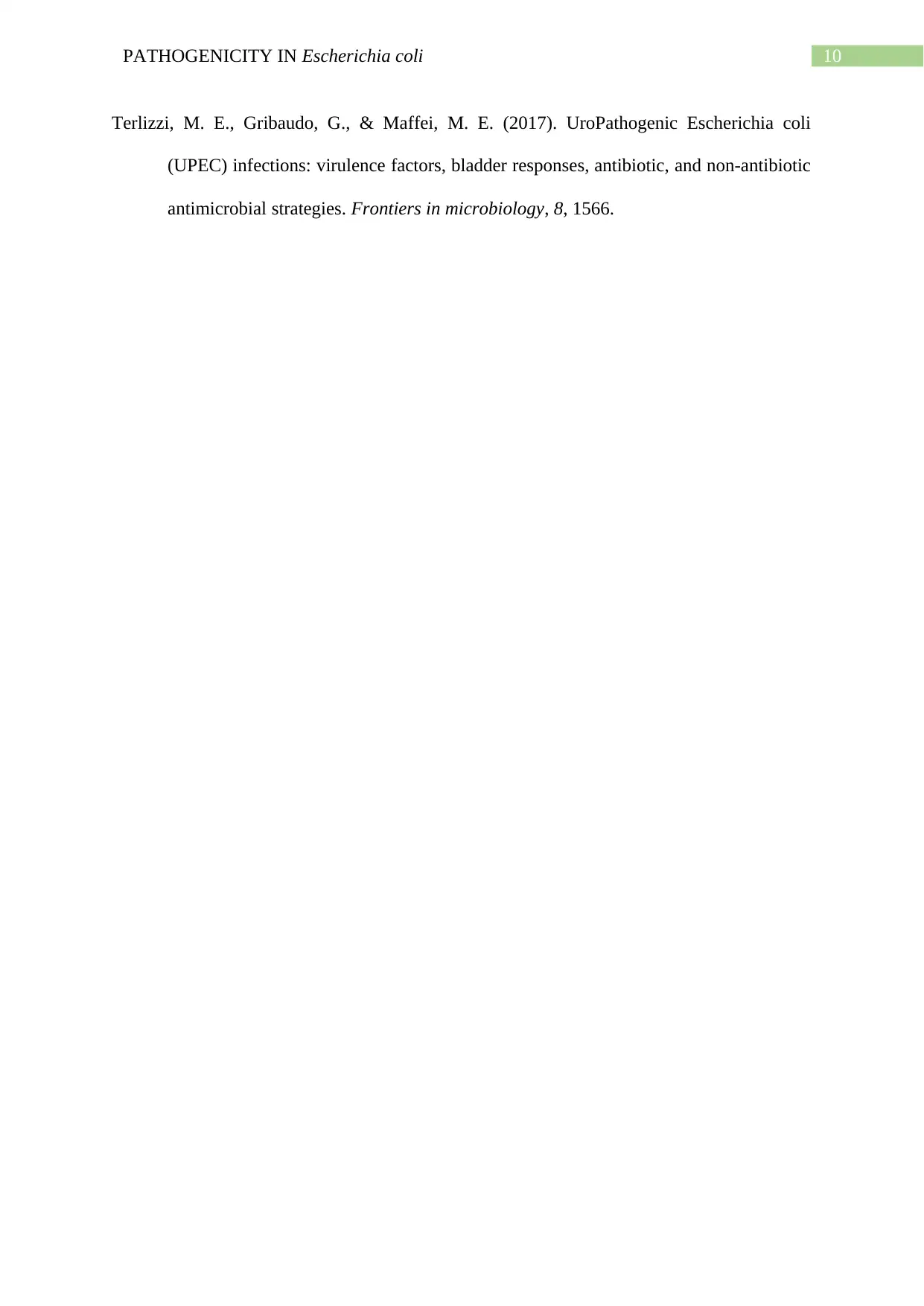
10PATHOGENICITY IN Escherichia coli
Terlizzi, M. E., Gribaudo, G., & Maffei, M. E. (2017). UroPathogenic Escherichia coli
(UPEC) infections: virulence factors, bladder responses, antibiotic, and non-antibiotic
antimicrobial strategies. Frontiers in microbiology, 8, 1566.
Terlizzi, M. E., Gribaudo, G., & Maffei, M. E. (2017). UroPathogenic Escherichia coli
(UPEC) infections: virulence factors, bladder responses, antibiotic, and non-antibiotic
antimicrobial strategies. Frontiers in microbiology, 8, 1566.
1 out of 11
Related Documents
Your All-in-One AI-Powered Toolkit for Academic Success.
+13062052269
info@desklib.com
Available 24*7 on WhatsApp / Email
![[object Object]](/_next/static/media/star-bottom.7253800d.svg)
Unlock your academic potential
Copyright © 2020–2025 A2Z Services. All Rights Reserved. Developed and managed by ZUCOL.





